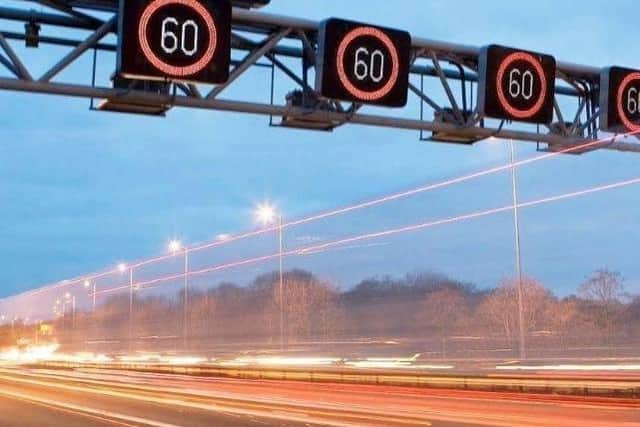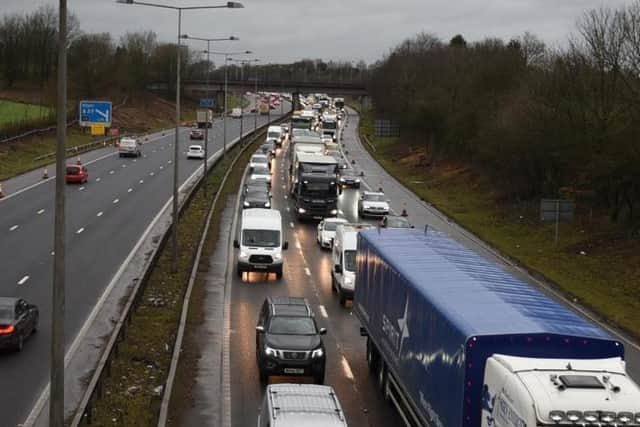'We don't want a death trap', say campaigners against smart motorway in Wigan
and live on Freeview channel 276
Don Hodgkinson, who lives in Liverpool Road, Ashton, just off one of the junctions where the 10-mile stretch of motorway will run, called for smart motorways to be scrapped.
Highways England work on the M6 - from junction 21a near Warrington to junction 26 near Wigan - begins in late March and is due to be completed by spring 2023.
Advertisement
Hide AdAdvertisement
Hide AdThe all-lane running motorway will have no hard shoulder although there will be 10 new emergency areas.


Mr Hodgkinson, an ex-Independent councillor in Bryn, said: “Some of us got a card through the door about 10 days ago, but you more or less have to live right near the motorway to get one.
“These smart motorways are very dangerous and there’s been a lack of publicity from Wigan Council and the other authorities about this scheme.
“The council’s attitude is it’s down to Highways England and they can’t do anything, but they should be getting the views of residents and telling them to accept it or try and stop it.
Advertisement
Hide AdAdvertisement
Hide Ad“It’s so important as they’re so dangerous and with these safe lay-bys, you might get two cars on them if you’re lucky and certainly no more than one lorry.


“There will be ten of these on the stretch but they are few and far between.”
Mr Hodgkinson, 86, said a “re-think was needed”.
He said: “There have been quite a few deaths on these motorways and lots of accidents and near misses and they actually make congestion worse.
“They really are a death trap and need to be scrapped.”


He added that fellow ex-councillor Paul Tushingham also had concerns about the motorways.
Advertisement
Hide AdAdvertisement
Hide AdRoad safety charities have also expressed concerns about smart motorways.
Joshua Harris, director of campaigns at Brake, said: “It is vital that the Government is led by the evidence when it comes to safe road design and, in particular, the rollout of smart motorways.
“The dangers facing people who break down on a stretch of motorway, without a hard shoulder, must be thoroughly examined and resolved so that the public can be confident in the safety of the roads they’re using.


“The government’s smart motorways stocktake was an important piece of work and we need to see the actions to improve safety rolled out across the network as soon as possible.”
Advertisement
Hide AdAdvertisement
Hide AdRebecca Lush, of the Transport Action Network campaign group, also told the Daily Mail that Highways England are going against the orders of Grant Shapps by ploughing ahead with another dangerous motorway.
She added that it was time Grant Shapps cancelled the smart motorway programme “before more lives are lost.”
Deaths on smart motorways on the increase in recent years, with 14 recorded in 2019
Smart motorway deaths have reached a record high in recent years.
Advertisement
Hide AdAdvertisement
Hide AdIn 2019, there were 14 fatalities on the motorways, according to figures from the Department of Transport seen by the Sunday Times.
This data was not published in the DfT’s annual report on road casualties, the newspaper said.
The 2019 death toll was a sharp rise from 11 deaths in 2018 and five in 2017.
But the Sunday Times said the true 2019 death toll could be 15 since one passenger died after spending seven weeks in hospital as a result of a smart motorway collision.
Advertisement
Hide AdAdvertisement
Hide AdAmong the deaths on smart motorways have been Jason Mercer who died in a crash on part of the M1 near Sheffield with no hard shoulder in June 2019.
Mr Mercer’s widow Claire told the Sunday Times: “People are starting to realise the emergency of it.
“Smart motorways need to be scrapped. We need the hard shoulder back – it is the only way that we will stop this dangerous situation. All motorways need a hard shoulder all of the time.”
Inquest documents relating to the accident, which saw Mr Mercer and Alexandru Murgeanu, 22, killed when a lorry driver crashed into their vehicles, will be examined.
Advertisement
Hide AdAdvertisement
Hide AdThe coroner David Urpeth found that Mr Mercer and Mr Murgeanu were unlawfully killed.
He said the smart motorways contributed to their death and warned there was “an ongoing risk of future deaths” without a hard shoulder, adding that he would write to Highways England and Transport Secretary Grant Shapps to request a review of the roads.
And South Yorkshire Police and crime commissioner (PCC), Dr Alan Billings, said a stretch of M1 in the area that has no hard shoulder poses a “constant danger.”
‘The safety and peace of motorists and passengers remains the priority,’ says Transport Secretary
Advertisement
Hide AdAdvertisement
Hide AdTransport secretary Grant Shapps has voiced concerns over smart motorways but continues to back them.
The Secretary of State has pledged £500m towards safety improvements and for Highways England to speed up work in some stretches of motorway.
The cabinet minister said the “safety and peace of mind” of motorists and passengers remains the priority.
In March 2020, he published an “evidence stocktake” which stated that “in most ways” they are as safe or safer than conventional motorways.
Advertisement
Hide AdAdvertisement
Hide AdBut it also said the chance of a crash involving a moving vehicle and a stationary vehicle is higher when the hard shoulder is removed.
Mr Shapps also gave his reasons earlier this month why he would not scrap the network.
He said: “A lot of people say, ‘Just undo it,’ and I have looked at that. It would require the equivalent land for 700 Wembley stadium-sized football pitches to somehow undo it all.
“We would have to buy people’s homes and destroy acres of green belt. I do not see that there is a route through to simply undoing it. We have to make what is there safe.”
Advertisement
Hide AdAdvertisement
Hide AdMr Shapps also told the Commons transport committee this month that he was making smart motorways safer, and said he did not approve of the fact emergency refuge areas have sometimes been spaced way too far apart.
He said: “Ideally, they have to be three quarters of a mile and no more than a mile.
“I have ordered Highways England to put in more emergency areas.”
On the issue of figures which shows a record number of fatalities in 2019, the DfT has said it is misleading to draw conclusions on safety based on data for a single year, and that doing so over a longer period of time provides a more accurate picture.
Advertisement
Hide AdAdvertisement
Hide AdMr Shapps also outlined an 18-point action plan to boost their safety after an inquiry last year - but also signalled that smart motorways were here to stay.
By 2025, dynamic hard shoulders will be phased out - a move that the government says will reduce confusion, but also means there will be no hard shoulders at all on more UK motorways in future.
And extra emergency refuge areas will be built to allow cars to pull over safely at shorter intervals, reducing the maximum distance to one mile between refuges.
‘We are aware of ongoing concerns, says Highways England
Transport bosses have said their main aim is to keep smart motorways as safe as possible and that they are aware of “ongoing concerns”.
Advertisement
Hide AdAdvertisement
Hide AdHighways England, the government-owned company charged with operating England’s motorways and major A roads, said an “evidence stocktake” published by transport secretary Grant Shapps in March 2020, shows that smart motorways are just as safe if not safer than conventional ones.
Although, the stocktake acknowledged they were not as safe in every way.
A Highways England spokesman said: “Safety is our top priority and we are absolutely committed to making our roads as safe as possible. In March 2020 the Government published a smart motorway evidence stocktake and action plan which found that in most ways smart motorways are as safe as, or safer than, the conventional ones – but not in every way.
“We are aware of the ongoing concerns. We have already completed some of the actions set out in the action plan and are working hard to deliver the remainder.”
Advertisement
Hide AdAdvertisement
Hide AdIn March, Highways England will launch a publicity campaign to raise awareness for basic safety on smart motorways. Communication campaigns have already seen them educate drivers how to use smart motorways, including the importance of obeying red X signs.
Increasingly, Emergency Refuge Areas (ERAs) are also painted in orange to help drivers spot them, and there are more signs directing drivers to their next ERA.
The organisation said: “At the transport secretary’s request, we are currently preparing a progress report against his evidence stocktake and action plan which will include analysis of latest safety data.”
It has also published statistics from data gathered since the first smart motorway opened in 2006 to say that journey reliability has improved by 22 per cent and personal injury accidents have been reduced by more than half. The plan is to continue expand the smart motorway network across the UK, including sections on the M1, M4, M5, M6, M25 and M62.
Advertisement
Hide AdAdvertisement
Hide AdThis covers around 500 miles, with an additional 300 miles planned by 2025.
So, what exactly is a smart motorway?
Usually a smart motorway is one without a hard shoulder which allows traffic to use the additional lane.
The two main types are all-lane running, where the hard shoulder has been permanently converted to become the inside lane, and dynamic, where it is only used by moving traffic at certain times.
They all have overhead electrical signs to signal emergency lane closures and reduced speed limits to manage congestion.
Advertisement
Hide AdAdvertisement
Hide AdThe motorways employ active traffic management techniques to increase capacity through the use of MIDAS technology including variable speed limits and occasionally hard shoulder running and ramp metering at busy times.
At the turn of the 21st century, they were developed as a cost-effective alternative to traditional carriageway widening, with intended benefits ranging from more reliable journey times to lower vehicle emissions.
The first mandatory variable speed limits were used on the M25 between junction 10 and junction 15 in 1995, but it wasn’t until 2006 that the UK first introduced dynamic hard shoulders, while major motorways first started using all-lane running in 2014.
The aim was to add capacity to the motorway network to deal with increasing traffic, without building additional roads or widening existing ones.This involves much more disruptive work, demolitions and land take.
Advertisement
Hide AdAdvertisement
Hide AdBut some transport analysts argue that adding road capacity simply encourages extra journeys and adds to traffic.
A lot of people are also convinced that smart motorways are more dangerous than conventional ones, citing cases where it seems clear that a hard shoulder would have saved lives.
Seven in 10 of those surveyed for the RAC Report on Motoring 2019 said they felt removing the hard shoulder on motorways compromises safety.
However figures analysed by the Department for Transport between 2015 and 2018 show the death toll on smart motorways by traffic volume has been slightly lower than on conventional motorways, possibly because speeds are often limited.
Thanks for reading. If you value what we do and are able to support us, a digital subscription is just £1 for your first month. Try us today by clicking here and viewing our offers ...